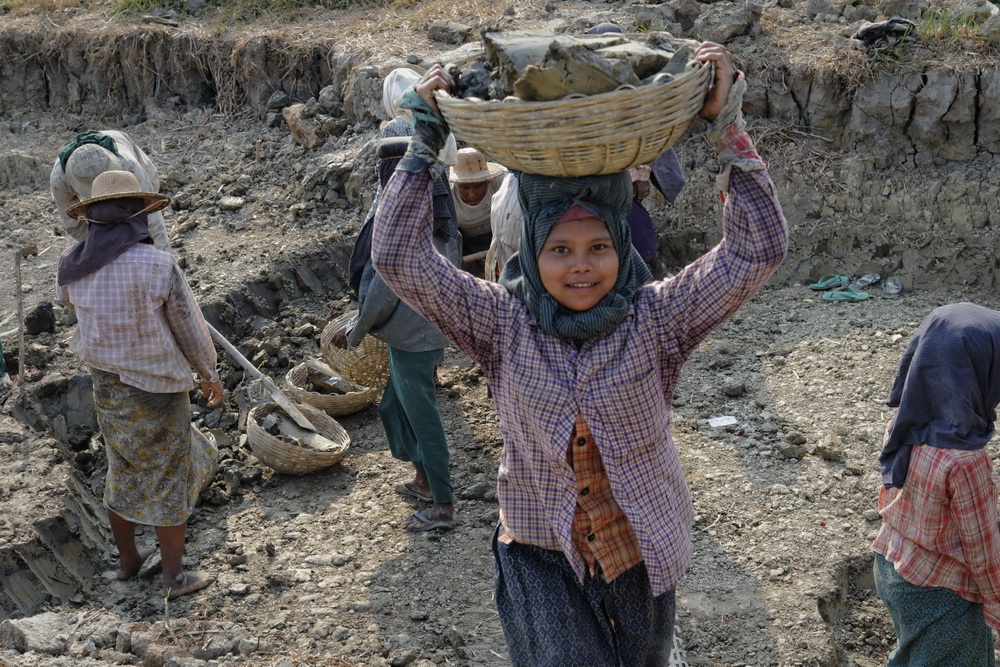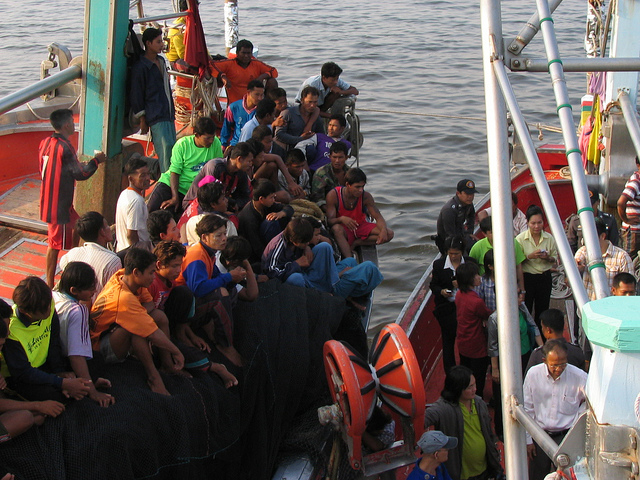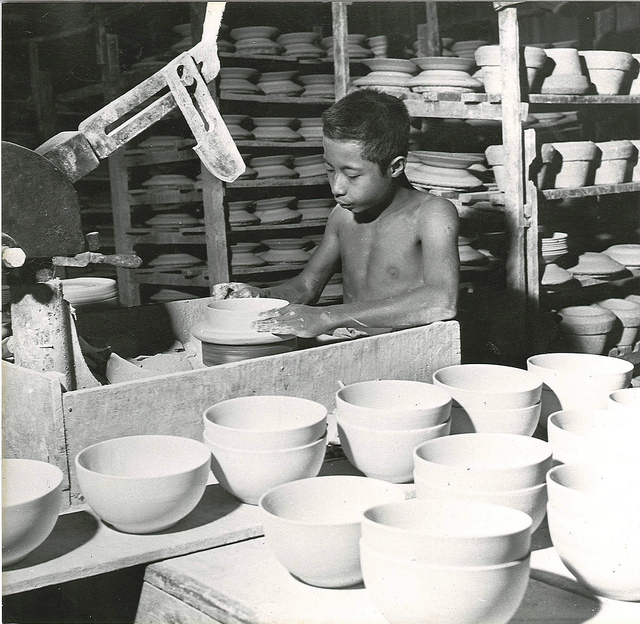The
rapid growth of a young adult population in Myanmar will affect the
socio economic development plan of the country. Investment in skills
development, employment and livelihood opportunities is necessary to
cater for the growing and the emerging youth bulge to create favorable
conditions for a demographic dividend in Myanmar.

Myanmar worker carrying a basket. Photo by International Labour Organization, Flickr taken on May 2013. Licensed under CC BY-NC-ND 2.0
The country’s labor force participation rate—the
percentage of employed people older than 15 years— was 63.4 percent in
2014, with almost double the percentage of men to women, with 81.7
versus 47.1 percent respectively. According to the census figures, 3.9
percent of the labor force were actively seeking but could not find
work. The union unemployment rate for men and women were similar, at 4
percent and 4.2 percent respectively.7
The
proportion of employed people by occupation was highest in the “Skilled
Agriculture, Forestry and Fishery Workers” category at 42.9 percent.
The second-largest employment categories are “Elementary occupation”
with 16 percent, followed by “Service and sales worker” at 13 percent.
“Craft and related trade workers” was also high, employing 11.7 percent
of employed people.8
The chart below shows the labor force participation rate and unemployment rate from 2014 Census.
Labor laws
Myanmar’s
labor protection is formed by a patchwork of many different labor laws,
many of which were enacted between the 1920s and 1950s. As with many
other laws introduced by the British colonial administration, most of
the labor laws from colonial period have survived and been effective
until recently.In recent years, the government has made an effort to
update the national labor laws and provide stronger protections for the
local workforce.9
For
example, the Workers’ Compensation Act of 1923 was amended in 2005, and
the Trade Union Act of 1926 was reformed in 2012. The Trade Union Act
was one of the first laws to be repealed after the political reform in
2011 together with the Trade Disputes Act of 1929, which were
respectively replaced by the Labor Organization Law in 2011, and the
Settlement of Labor Dispute Law in 2012. The payment of Wages Act of
1936 is still in effect.10
Myanmar
does not have a work permit system in place for the employment of
foreign workers. Foreign nationals who need to reside and work in
Myanmar for long periods of time must obtain both a Stay Permit and a
special re-entry visa, which are readily available for employees of
companies that hold an investment permit from the Myanmar Investment
Commission.11
Child Labor
The
estimated number of children in Myanmar was 12.146 million, with about
10.5 percent of this number working, totalling 1.279 million working
children. Of these, 52.9 percent (676,208) were boys and 47.1 percent
(602,701) were girls.The definition of working children in the 2014
Myanmar census is as follows: those whom during the past seven days have
been engaged for one hour or more, on a full-time or part-time basis,
paid or unpaid, in the production of goods and services that have a
market value.
In Myanmar, over 77 percent of
children between 5 and 17 years are attending school, This privilege
does not extend to the majority of children in the labor force, with
only 0.3 percent of working children being able to attend school,
according to the statistics from the International Labor Organization
(ILO).
The ILO defines hazardous occupations
for children as “work that is physically, psychologically, socially or
morally dangerous and harmful to children, including long and heavy
hours of work.”
According to the statistics from the International
Labor Organization (ILO), 40 percent of children in hazardous workplaces
were in environments contaminated by dust and fumes, while 16.3
percent were working with dangerous tools. A further 11.2 percent of
children were exposed to extreme cold or heat in their working
environment, 9.8 percent were exposed to dangerous chemicals and 9
percent were exposed to other workplace hazards.
Read more about illegal labor in Myanmar.
Health and safety
Myanmar
became a member of the ILO in 1948, and has received their financial
and technical assistance to improve occupational safety & health
(OSH) since then. However, the ILO’s national profile on Myanmar’s OSH
framework found that existing laws, acts, rules & regulations
relating on occupational safety & health (OSH) are not up-to-date,
do not cover all workplace hazards, and many had not been amended yet.12
On
22 November 2015, a major landslide in Hpakant, Kachin State, northern
Myanmar killed at least 116 people near several jade mines, more than
100 others were missing. That is the fourth time a massive landslide
occurred at a jade mine in Kachin State in recent times. Many of those
were people who made their living searching on or near the waste dumps,
in the hope of finding piece of jade to sell.13
The
chart below shows the monthly wages by gender, urgan/rural and sector
according to a survey by International Labour Organization.
Wages
A
new minimum wage law, passed in March 2013, replaced the 1949 Minimum
Wage Act. The new minimum wage is not announced yet by November 2013,
though the Ministry of Labor in 2012 set up as temporal minimum wage
56,000 kyat (US$65) per month after serious disputes in garment
factories.
According
to the ILO statistics, for all employees, the average wage per day was
4,760 Kyats and for the daily wagers 4,280 Kyats. It is much higher in
urban areas than rural areas. Similarly males get higher wages than
females. The service sector has the highest wage rates.14
Migration
The
2014 Census shows that 53 percent of all people who moved from their
previous place of usual residence within Myanmar were female. The main
reason for movement for both sexes was “following family” and
“employment/seeking employment.” Females were more likely to follow
family (49%) than males (32%); and males migrated more for reasons of
employment (47%) than females (23%).15
25
per cent of the persons changed their place of residence due to
employment purposes. Employment purpose here refers to in search of
employment or business opportunities; to take up new employment or start
a new business; and job transfer. 53 per cent of people changed their
usual place of residence due to the movement of their family. The third
important reason was marriage. Most of the people moved to Yangon for
employment purposes.16
According to the census data,
there are approximately 2 million former household members living
outside of Myanmar. Of these, about 1.2 million are male, representing
61 percent of the total population are reported to be living out of the
country. About 70 percent of those living outside Myanmar were reported
to be living in Thailand, while 15 percent were in Malaysia. The census
shows that out of the approximately 2 million people reported to be
living abroad, about 1.7 million are between the ages of 15 and 39 (83
percent) and up to 1.1 million in this age bracket are male.17
Illegal Labor
A lack of legitimate job opportunities in Myanmar has
contributed to a shadow economy of informal or illegal labor, operating
both within and outside the country’s national borders. Informal labor
is prevalent in a range of economic sectors and affects a broad spectrum
of demographics.
Human Trafficking

Migrant
workers, mainly from Myanmar and Cambodia, are the main workforce for
Thailand’s fishing industry. Photo by International Labour Organization,
taken on February 4, 2015. Licensed under CC BY-NC-ND 3.0.
Traditionally
working in border regions, where the government’s oversight is limited,
human trafficking networks in Myanmar now extend to the country’s major
cities.
Although Myanmar people are trafficked to
other Asian countries, such as China, Bangladesh, Malaysia, Korea and
Macau, the primary destination is Thailand. Approximately 600,000
Burmese migrants are registered to work in Thailand, but many more are
there illegally.1
Many
people are trafficked to Thailand to work in agriculture, fishing,
construction, factories, domestic work and the sex industry. Local
traffickers use deceptive tactics to recruit men into forced labor on
palm oil and rubber plantations or in jade and precious stone mines.2
Women
and girls are primarily subjected to sex trafficking, domestic
servitude, or forced labor in garment manufacturing. Trafficking groups
typically lure or force women and children into sex work, primarily in
Thailand and China.5 Children are subjected to sex trafficking or to
forced labor in teashops, the agricultural and construction sector, and
in begging, at times through debt bondage. Both children and adults are
subjected to forced domestic servitude. 3
A
global index on modern slavery stated that some 30 million people are
enslaved worldwide and 384,000 people are enslaved in Myanmar.4
Modern slavery is when one person possesses or controls another person
in such a way as to significantly deprive that person of their
individual liberty, with the intention of exploiting that person through
their use, profit, transfer or disposal.5
Myanmar enacted the Anti-Human Trafficking law in September 2005.
According to official statistics, the government exposed 1,168 cases
between 2006 and April 2015, rescuing more than 2,000 victims and
arresting 2,106 traffickers. 6
Child Labor

Burmese boy making pottery. Photo by International Labour Organization, taken on October 17, 2013. Licensed under CC BY-NC-ND 3.0.
Child
labor is widespread problem throughout Myanmar. Many of the children
are recruited by agents and employed in tea shops or as restaurant
attendants, street vendors, manual labor, waste collectors or beggars,
in food processing and light manufacturing industries, and on farms in
rural areas.7
The
estimated number of children in Myanmar was 12.146 million in 2014,
with about 10.5 percent of this number working, totalling 1.279 million
working children. The definition of working children in the 2014 Myanmar
census is: “those whom during the past seven days have been engaged for
one hour or more, on a full-time or part-time basis, paid or unpaid, in
the production of goods and services that have a market value.”8
According
to the statistics from the International Labor Organization (ILO), 40
percent of children in hazardous workplaces were in environments
contaminated by dust and fumes, while 16.5 percent were working with
dangerous tools. A further 11.2 percent of children were exposed to
extreme cold or heat in their working environment, 9.8 percent were
exposed to dangerous chemicals and 9 percent were exposed to other
workplace hazards.9
In
Myanmar, over 77 percent of children between 5 and 17 years are
attending school, This privilege does not extend to the majority of
children in the labor force, with only 0.3 percent of working children
being able to attend school, according to the statistics from the
International Labor Organization (ILO).10
Commercial Sex Labor
There are an estimated 70,000 sex workers in Myanmar. About 8 percent of them are living with HIV, reported The Myanmar Times.11
Sex
workers in Myanmar are mainly women, but homosexual and heterosexual
men also provide sexual services. Child prostitution involves young
girls and an increasing number of boys.
In many
cases, brokers promising high-paying jobs lure women to distant foreign
cities. The brokers regularly charge the women for transportation, food
and other costs of living, in exchange for helping the women find work.
In some cases, brokers trick women into becoming prostitutes, promising
high-paying jobs without informing women of the actual work.12
In
Myanmar the Suppression of Prostitution Act of 1949 stipulates that the
act of soliciting or seducing in public is illegal, with offenders
facing one to three years of imprisonment. The punishment is aimed
solely at the sex workers and clients are not punished under the law.13
In
addition to laws against prostitution, Myanmar has laws protecting
minors and specifically prohibiting child prostitution. However, these
laws are not enforced and many women under the age of 18 work as
prostitutes.
Ref:https://opendevelopmentmyanmar.net/topics/labor/




No comments:
Post a Comment